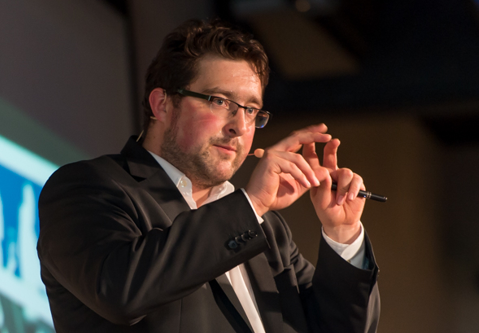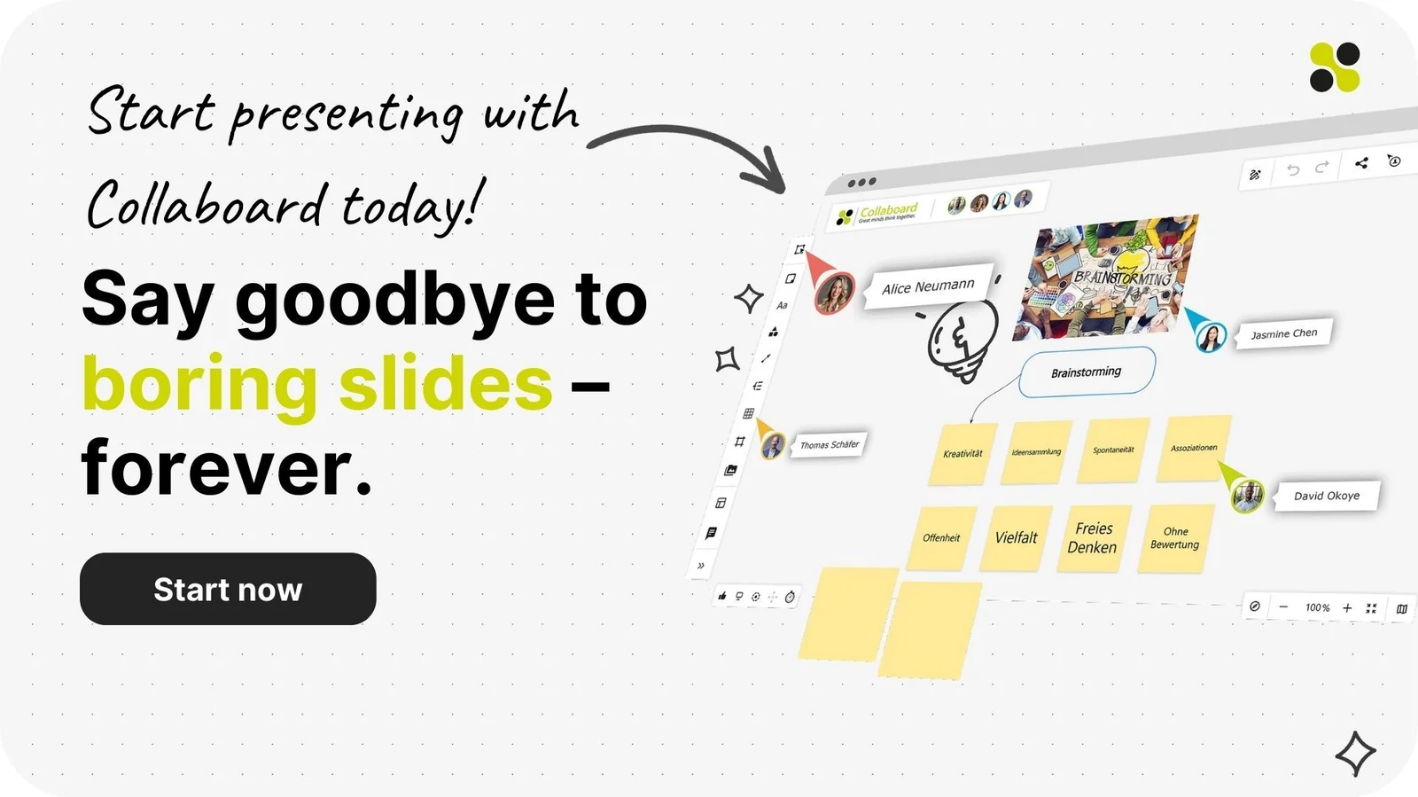Ending a presentation is like adding the last stroke of a painter's brush - it rounds off the overall picture and creates a lasting impression. But how do you create a powerful end to a presentation that the audience will remember? Let's discover the secret together in this article.
What do you say at the end of a presentation?
You have given a convincing presentation, addressed everything important and got your message across effectively. Now you are faced with the challenge of finding a successful conclusion. This is where the right words matter. A simple "That's it" or "Thank you for your attention" will probably not be remembered by your audience. Instead, you can use a summary of your main points, a call-to-action or a catchy conclusion to leave a strong impression.
Why the end of your presentation is so important?
The end of a presentation is your last chance to leave a lasting impression. It gives you the opportunity to reinforce your message and inspire your audience, or spur them into action. It's not just about wrapping up your presentation, it's about ending it with a bang. Use this opportunity to reiterate your core message and make a strong emotional connection with your audience.
The principle of the recency effect
The recency effect states that people remember best what they heard last. This underlines why the end of your presentation is so important. If you design the end of your presentation effectively, your audience is more likely to remember it. Use this psychological phenomenon to your advantage and ensure that your conclusions and calls to action are remembered.
Presentation end: 7 examples to leave a lasting impression
- Summarize the main points: Repeat the main points of your presentation to reinforce them.
- Call-to-action: Ask your audience to perform a specific action or take a next step.
- Quote: A relevant and powerful quote can leave a lasting impression.
- Story or anecdote: A short, relevant story or anecdote can create an emotional connection and stick in the audience's mind.
- Questions: Ask a rhetorical or open-ended question that is thought-provoking.
- Surprising statistic or fact: An impressive statistic or fact can make a strong impression.
- Humorous remark: A funny remark or joke can lighten the mood and ensure a positive ending.
How to formulate a strong presentation ending
Formulating a strong presentation ending requires practice and creativity. Try to convey your core message in a way that suits your audience and your topic. Remember that your goal is to leave a lasting impression. Be clear, concise and engaging. Use metaphors or stories to illustrate your points and use rhetorical devices such as repetition and triples to reinforce your message. Here are some examples of how you can conclude your presentation:
- Summary and outlook: "Today we discussed the challenges and solutions for our product development. By implementing these solutions, our company will be even more innovative and efficient in the future."
- Call to action: "Now you know the advantages of our product. Let's exploit the opportunities that arise from this together. Let's start implementing it today!"
- Interaction question: "What do you think of these suggestions? Which measures do you see as a priority to achieve our goals?"
- Inspirational quote: "As Albert Einstein said: 'Life is like riding a bicycle. To keep your balance, you have to keep moving'. So let's keep moving and pursue our goals together."
- Positive outlook: "I am confident that with these strategies we can achieve our goals and continue our success."
Each of these closing formulations has its strengths. Choose the one that best suits your style, your audience and your topic. Find out here how you can structure your presentation to create the perfect ending.
Presentation end - Rhetorical questions as a tool
The dos and don'ts for a successful end to a presentation
It is crucial to design this finale in such a way that it is effective and memorable. To help you do this, here's a clear list of dos and don'ts to keep in mind at the end of your presentation. These tips will give you guidance to captivate your audience until the curtain falls.
| Dos | Don'ts |
| Be clear and precise in your message. | Avoid giving too much information. |
| Keep up the interest until the end. | Do not end abruptly without a summary. |
| Use visual elements to inspire. | Do not use confusing or irrelevant graphics. |
| Involve the audience, e.g. by asking questions. | Don't ignore the feedback and reactions of the audience. |
| Ending with a strong, memorable point. | Avoid repeating important points or messages. |
How long should the end of a presentation last?
Make the end of the presentation fun
Humor can be a great way to end your presentation in a light and enjoyable way. A joke or funny anecdote can lighten the mood and make your audience laugh. However, make sure the humor is appropriate and relevant to your topic.
What comes at the end of the presentation?
The closing slide of your presentation is your last chance to make a lasting impression. It should summarize your main points and include a call-to-action. You can also include your contact details or links to further resources. Make the closing slide engaging and easy to read to reinforce your message.
Take your presentations to the next level with Collaboard
End of presentation: The art of making a lasting impression
The end of your presentation is more than just a conclusion. It's your chance to leave a lasting impression, reinforce your message and inspire your audience to take action. Take advantage of this opportunity and use techniques such as repeating your main points, asking rhetorical questions or adding humor to end your presentation effectively. Remember the principle of the recency effect and design your presentation to be memorable. No matter which method you choose, be authentic and stay true to yourself. Your audience will thank you for it.
Checklist: Effective end of presentation
This checklist will help you evaluate the effectiveness of your presentation ending and make sure you've covered all the important aspects. From the clarity of your message to the emotional resonance, these points are crucial to captivating your audience and leaving a lasting impression.
- Clarity of message: Has the main message of your presentation been clearly communicated?
- Answering audience questions: Were relevant questions from the audience addressed during or at the end of your presentation
- Visual impact: Was a strong, powerful image or graphic used effectively to reinforce the message?
- Audience engagement: Were techniques such as direct questions, interactive elements or calls to action used to actively engage the audience?
- Emotional resonance: Did the end of your presentation evoke an emotional response, be it inspiration, thoughtfulness or joy?
- Summary of content: Were the main points of your presentation summarized clearly and concisely?
- Lasting impression: Does the end of your presentation leave a strong, lasting image in the minds of your audience?
- Learn here more about how to design a professional presentation
Case study: Impressive presentation endings
There are presentations that continue to occupy and inspire us long after they have finished. It's often the ending that leaves a lasting impression. To understand how to design a professional presentation ending, let's take a look at two case studies.
Steve Jobs at Apple product launches
Jobs' famous "One More Thing..." technique was a masterstroke in the art of presentation. After introducing a series of products or features during the presentation, it seemed as if he had reached the end. But then came the moment everyone was waiting for: Jobs returned to the stage, often with the words "There's one more thing...". These words caused great anticipation and excitement in the audience. This approach was more than just a clever finish. It became a trademark of Apple events and a synonym for innovation and surprise. The "One More Thing..." moments were often the introduction of groundbreaking products or features that would shape the technology world. This technique not only enhanced the impact of the presentation, but also left a sense of awe and curiosity.
The power of storytelling in TED Talks
TED Talks have established themselves worldwide as a platform for some of the most inspiring and influential presentations. A key element that sets TED presentations apart is the way speakers end their talks - often with a personal story or transformative experience. These stories are not only poignant, but also a powerful tool to reinforce the message of the presentation.
Presentation end - Frequently asked questions & answers
How do you end a presentation appropriately?
A good ending to a presentation includes a summary of the main points, a convincing conclusion, words of thanks and a willingness to answer questions.
What phrases are suitable for closing a presentation?
Possible phrases could be: "To conclude...", "To summarize...", "In conclusion, I would like to say...", "This brings me to the end of my presentation...".
Should you ask questions at the end of the presentation?
Yes, it is common and recommended to open a Q&A session at the end of the presentation to clear up any ambiguities and encourage dialog.
How should you respond to questions that you cannot answer?
It is important to be honest and admit if you cannot answer a question. You can offer to provide the answer later or ask the audience if someone else can answer the question.
What should you do if no questions are asked?
If no questions are asked, you can ask some prepared questions to stimulate discussion or highlight other aspects of the topic.
How do you thank the audience at the end of a presentation?
A simple "Thank you for your attention" or "Thank you for taking the time to listen to my presentation" is an appropriate way to say thank you.




